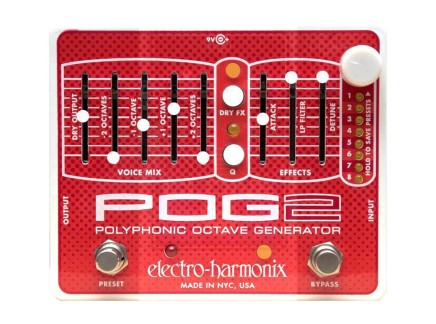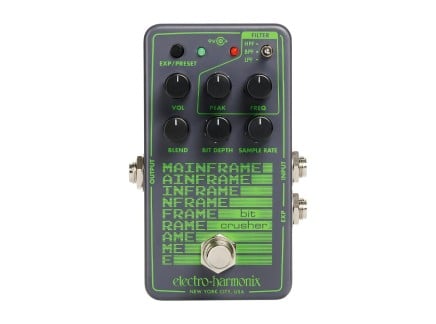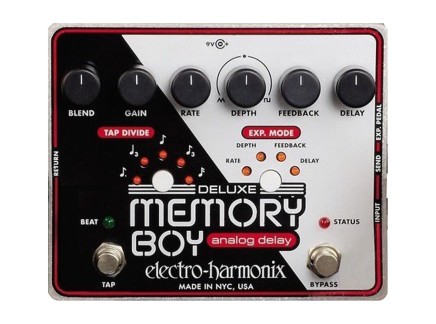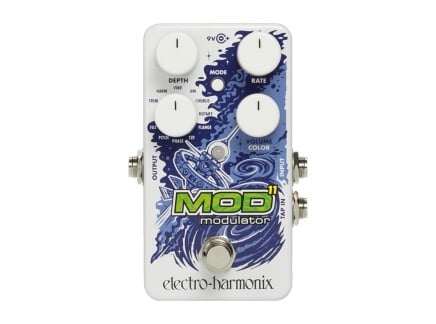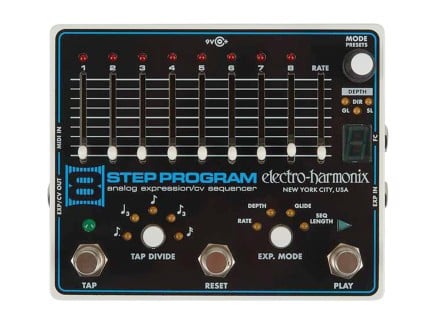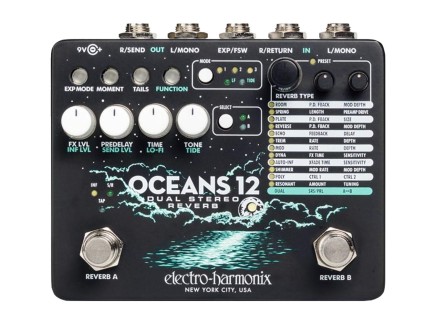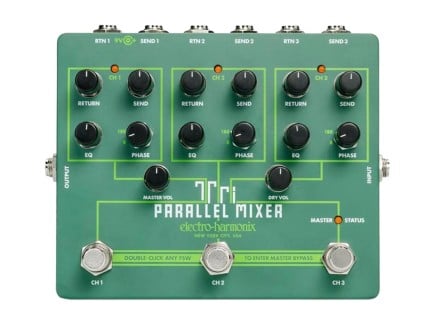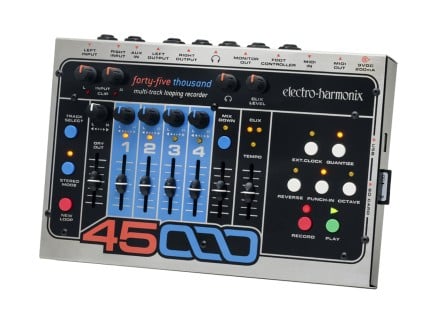If you're at all familiar with the world of guitar effects, you're surely aware of Electro-Harmonix: a long-standing leader in the world of audio processing. Founded by musician-turned-entrepreneur Mike Matthews in 1968—in the age of psychedelic studio techniques and fuzzed-out guitar tones—EHX was responsible for creating entirely new concepts in guitar signal processing altogether. 1968's LPB-1 Linear Power Booster purportedly was the beginning of overdriven amp tones; 1975's Electric Mistress was the first compact, self-contained flanger effect processor; 1976's Memory Man was the first commercially-available IC-based compact delay unit. From there, they've consistently made breakthroughs in pitch shifting technology, guitar synthesis, and much more.
Today, Electro-Harmonix's product lineup consists of well over a hundred distinct items...and unlike many pedal companies, EHX isn't just about overdrives and fuzz (though of course, they do have some of the most popular overdrives and fuzzes on the market). As in the past, Electro-Harmonix isn't afraid to get weird—and as such, they have a number of processors that break out of the conventional "guitar pedal" paradigm and into more esoteric, peculiar corners of sound design. And of course, to our delight, their pedals work spectacularly with basically anything you pass through them, making them an excellent tool for guitarists, synthesists, bassists, and studio musicians alike.
In this article, we're taking a closer look at ten of our favorite oddball EHX effects, proving that there's much much more to this company than the Big Muff. If you're interested in exploring creative pedals for sound design and electronic music, read on.
Brian's Picks: Superego+ & POG2
Electro-Harmonix has steadily developed their line of synth engines and signal manipulators over the past decade with pieces like the Freeze, Attack Decay, xx9 Series, the Superego, and the pedal we're going to focus on now, the Superego+. With an added Threshold, dedicated Attack and Decay knobs, as well as 11 onboard effects, it packs a ridiculous level of flexibility into a small package. You can dial in almost any modulation effect with a unique flavor, however, we're going to focus on one area where this happens to excel: textural evolution of long passages.
Let's spend some time in the Auto mode, which automatically freezes portions of the incoming audio signal and can generate synth-like sounds by treating these frozen bits of audio like an oscillator. This pedal excels at creating lovely stacked textures which can build up with the Layer knob at 100%, or each new layer can slowly—or quickly—fade away. One issue is that the frozen signal can sometimes be unwieldy—but this is where the Filter effect in particular can come in handy. By dialing the Dry all the way down and adjusting the Effect knob, you can get interesting plucky sounds and lush pads by adjusting the Attack and Decay knobs to taste; engage the Filter and there you go: a simple, effective synth-like voice. Using the Gliss and Layer knobs can give you even more control over the sound from slow rising pads, to quirky bubbling leads. With enough care, you can get a very musical, Jon-Hassellian movement by using a touch of Gliss.
Just like the original Superego, the SE+ has an effects loop that will feed the synth engine through an external effect chain, opening up the creative possibilities even more. One exceptional addition to the effects chain is the POG2, in part because of the built-in LP Filter. Indeed, with the Filter on the SE+ and the LP filter on the POG working together, you have the ability to dial in the sound with a fine amount of control. The Attack slider also functions as a wonderful dynamic utility giving you the ability to create blooming octaves: the sliders in general on the POG2 are a thing of beauty when creating evolving performative dronescapes. Much like working with a mixer's faders, the interface on the POG2 gives you a natural movement and encourages intuitive gestures.
Electro-Harmonix is known for having rock solid pitch tracking and octave generation from their large HOG2 down to the Nano POG. We're going to look at the POG2, which is a nice in-between, both in form factor and features. The nicest thing about the POG2 is the handy set of utilities it offers on the right side of the pedal. Attack, LP Filter, and Detune are all accessible via sliders, which makes them highly playable and suited for a desktop signal flow or in a loop-based pedalboard. Using the LP Filter slider you can sneakily roll off the +1/+2 octaves and have them sweep into focus at your pleasure. Being able to route the Dry signal into the filter is also a great way to add textural diversity in slow moving performances.
With the Octave sliders, you can continue the ebbing and flowing of +/- 2 octaves simultaneously and fade in the Dry signal to taste. Incredibly helpful when trying to get in a subtle amount of thickness or when spicing up a static signal. Instruments aren't the only thing that work with the POG2, a simple cassette player with a tape loop can blossom into a lush world of deep grit, high crinkles, or both with a simple move of the sliders. As mentioned in the Superego+ section, the Attack slider can create beautiful swells for the octaves, giving a nice afterimage effect with sustained sounds.
Iain's Picks: Mainframe & Pitch Fork+
EHX's Mainframe enhances the quality of your desired sonic palette by degrading the source you feed it through sample-rate and bit reduction. Crushing drums and aliasing synth leads, the Mainframe offers a variety of flavors with individual controls of the sample-rate, bit depth, and a dry/wet blend that sounds spectacular for dialing in the perfect amount of dirt. The provided multimode filter sounds super clean with not a lot of character, something I find desirable in managing and sculpting lofi sounds. I really enjoy using the expression/CV to modulate the sample-rate over time for slight warbles or extremely sequenced results on pads and keys.
Something I didn't realize until I dove into the manual was the customization you can put into the Mainframe through the secondary knob settings. A hidden feature, secondary knob settings include constraining the sample-rate to musical half-notes (giving you full access to a chromatically scaled sample-rate), varying bit depths based on the incoming signals level, access to a switchable 2nd/4th order filter, and input gain control capable of hard clipping. Using variable bit-depths is an interesting way to get parallel gated drums or synth stabs/plucks that have dynamic range to work with.
The most impressive aspect of the Mainframe in my opinion is sample-rate tuning mode, accessible by a double-tap of the footswitch. In this mode, the sample-rate now follows the pitch of your signal input (best on monophonic sources) and can playback the sample rates not only at a unison interval, but also extends fifth and octaves up to four octaves! I really enjoy making bass synths sound larger than life by adding octaves, and incorporating slight bitcrushing while driving the input gain can give your sound punch and height. Sending polyphonic information will freak it, but even that can be great for sampling and mangling or as an odd choice of effects for live performance.
Bitcrushing has had a huge impact on many genres of music over the past several decades, and with the rise of lofi beats and lofi house over the past few years, adding a bitcrusher to your arsenal rather than tape effects and vinyl crackle might give you an edge that most people aren't exploring in such genres.
The Pitch Fork+ by Electro-Harmonix is a dual polyphonic pitch shifter that builds on their simpler Pitch Fork pedal—capable of +/- 3 octave transposition, full detune, and even more unique features such as cross modulation and an auxiliary output for advanced routing. That said, the depth this module provides is ridiculous, containing layers of submenus that make flexibility second nature. What's wonderful about such detail is that most controls allow you to dial in variable amounts of the effect, be it level of pitch shift, detune amount, and even the amount of cross modulation. All this information can be saved as individual presets, up to 100 of them available in total...allowing you to create and recall sounds at your discretion.
Outside the context of guitar processing, even polysynth owners like myself find use in extra voices, and using a pitch shifter can provide options like extended chords and odd polychords for jazzy implementations, or detuned unisons to make thick, lush pads and stabs. A feature I find extremely useful is the expression input, which, like most EHX expression pedal inputs, accepts CV signals; using modular synths or even my Analog Four, I like introducing sequenced or modulated pitch shifts to liven the sound up and inject complexity. This can be done to affect shift 1, 2, or both, allowing you to do complex harmonic progressions with passing tones and sliding pitches; pairing this with a touch of cross modulation can create nice FM tones that track differently than the incoming pitch. I could also see myself applying CV to control the volume to create automated tremolos or the glissando for flexible slides and jumps.
Changing the footswitch on Pitch Fork+ to a momentary effect introduces glissando with variable rise and fall times, allowing you to inject intervals that glide into whatever melody or bass line is being performed. Implementing this technique in a nontraditional way, such as on a drum or percussion source with solid fundamentals, can supply a more slidey tonal sound and softened transients. Noisier sources freak the Pitch Fork+ out and give you these glitchy and chaotic results. Choosing an XMOD algorithm and increasing the amount can provide effects from subtle sheen to gritty chaos; I love applying this to simpler tones like filtered saws or just pure sines for gnarl without it getting away from you, and adding just moments of this can really add zest and a performance feature to a sequenced loop.
It's important to recognize the impact pitch shifters, harmonizers, and vocoders have had on the way we sound design and make music. They not only provide pleasantly unnatural ways to create harmonic progressions, but also allow the artist to multiply a sound and reach further to create variation. That said, the Pitch Fork+ is a great addition to create vertical height and depth to any sound source, be it guitars, synths, voice, or anything your heart desires.
Ryan's Picks: Deluxe Memory Boy & Mod11
Many Electro-Harmonix pedals have a long legacy behind them—there are countless variations on the Big Muff, Polyphonic Octave Generators in all shapes and sizes, as many Small Stones, Holy Grails, and Electric Mistresses as you could possibly need. And then, there's the Memory Man: a legendary delay that has spawned countless offspring, no fewer than seven of which are still in production today. I want to bring attention to one of the overlooked members of this particular family (and one of my favorite pedals altogether): the Deluxe Memory Boy.
Deluxe Memory Boy is one of the more affordable options from the Memory series, offering a similar feature set as the Deluxe Memory Man 550-TT: built-in delay time modulation, tap tempo with selectable subdivisions, extensive expression pedal control, and an effects loop for adding other effects into the delay's feedback path. That being the case...what is the difference between the two? Slight functional differences aside, one of the most profound differences has to do with the sound quality—due to the fact that each uses different BBD chips, the Memory Man sounds significantly more bright and crisp, whereas the Deluxe Memory Boy sounds crunchier, darker, murkier.
For me, that is the makings of an excellent pedal. If you want a super clean, hi-fi delay, I don't think that Deluxe Memory Boy would be my first recommendation; but if you're looking for dark, distant, lo-fi analog repeats, then it's absolutely perfect. In fact, this is the go-to lo-fi pedal in my personal arsenal. By setting the delay time and feedback to minimum and dialing the mix fully wet, you get a murky, muted version of what you put into it, instantly making any sound seem much older. From there, it's worth noting that the built-in LFO allows delay time modulation via triangle and square waves as well, making it great for seasick warbles and peculiar echo trills. When using the "lo-fi" settings described above in conjunction with the LFO, you get the sounds of warbling tape and odd vibratos—add back some dry signal and you have a stellar, crusty-sounding chorus.
A bonus tip...try holding down the delay tap division button for a few seconds. You'll notice the LEDs for the tap division rate blinking in a cycle—you've entered an Easter Egg mode that allows you to cyclically switch through all of the tap division settings at a rate determined by the "Rate" knob (usually reserved for controlling the internal LFO rate). This results in peculiar pitch-shifted delay arpeggios not entirely unlike what you can get from a Chase Bliss Thermae (albeit much dirtier-sounding and less refined). Incredible. Deluxe Memory Boy does a surprising number of interesting, great-sounding things if you don't go into things expecting a hi-fi, studio-quality delay.
Another surprisingly affordable unsung hero of EHX's current lineup, the Mod11 provides loads of unique modulation effects in a tiny package—including a number of bizarre effects found in their other pedals. With eleven distinct modulation modes, it's a modulation-focused counterpart to the Oceans 11 Reverb, packing a ton of sonic potential into a single affordable pedal.
For a quick rundown, the Mod 11 includes modes for Tremolo, Harmonic Tremolo, Vibrato, Univibe, Chorus, Rotary, Flange, Thru-Zero Flange, Phaser, Pitch Shifting, and Filtering. Many of these effect types include alternate modes—for instance, the Chorus mode allows access to Small Clone-like chorus, as well as tri-chorus and a dedicated bass chorus mode. Many modes feature a hidden overdrive, while others feature an adjustable LFO with multiple wave shapes and variable rate/depth. It's not uncommon to see a modulation multi-effect with options like chorus, flange, rotary, etc., so I'm not going to focus on those in this description...but instead, I want to focus on a couple of Mod 11's particularly strong and unique effect modes.
The first, which can't be ignored, is the pitch shifter. As we discussed above, EHX pitch shifters are uncommonly good—handling chords with ease, and dissolving into pleasant chaos with more complex tones at extreme shift amounts. The pitch shifter in the Mod11 offers a handful of unique features that set it aside from many of their other offerings, and make it an excellent pitch shifter in its own right. Not only is it capable of straightforward pitch shifting: it also includes a dedicated LFO for modulating the shifted pitch. This can result in everything from smooth vibrato to rising/falling saw shifts and square trills—but perhaps more interestingly, the modulation can be quantized to specific scales/intervals while conforming to the selected shape. This means that it can generate arpeggio effects with a variety of shapes, with a variety of quantization settings: chromatic, whole tone, octaves, octaves+fifths, major arp, and minor arp settings are but a knob twist away.
Another particular strong and novel mode is the Thru-Zero Flanger (TZF)—similar to conventional flanging effects, but where the delayed signal passes through the sweep's zero point to create peculiar harmonic accentuations not possible on more typical flangers. For me, one of the most interesting settings with the TZF is the barber pole setting, which allows the flanger to sound as if it is continually rising or falling rather than sweeping back and forth in a typical LFO shape. This can be a great way of adding an unsettling edge to any sonic atmosphere—and it sounds excellent for adding shape/motion/direction to complex, noisy textures.
Of course, the other modes are excellent as well—the filter mode, for instance, is another strong point, featuring lowpass, bandpass, and highpass filter types with multiple LFO shapes and an envelope filter modulation option. Each mode offers its own quirks, tricks, and hidden features...so if you're looking for a modulation effect that you can really dig into, why not get eleven for the price of one?
Jacob's Picks: 8-Step Program & Clockworks
Being one of the most recognized pedal brands of all time, it should come as no surprise to know that Electro-Harmonix has produced a lot of different designs over the years. And when considering the success of heavy hitters like the Big Muff and Memory Man, there's been plenty of room for them to experiment with releasing some more niche designs here and there.
Parallel to the rising popularity of effects pedals in the 1970s was the growing interest and availability of synthesizers, sequencers, and eventually drum machines. While companies were shrinking down from expansive modular systems to fixed-architecture synths in an effort to increase affordability and ease-of-use to customers, many of these instruments, such as the Moog Minimoog, still had external control inputs to interface with the patch points of a modular synthesizer. But for the most part, unless you happened to attend or teach at a university, work in a premier recording studio, or simply be a world-famous musician, accessing a modular to expand your keyboard synth was no easy task at the time. Sensing the market appeal of small, pedal-sized enclosures offering synthesizer control methods, Electro-Harmonix was one of the companies to step up to the plate and produce comparatively affordable alternative solutions.
Today, the EHX lineup ranges from reissues of their most iconic circuits to fresh new designs, and still hiding among them are some useful tools for clocking and sequencing synthesizers, pedals, and more. Of these, the 8 Step Program and Clockworks serve as a potent combination for expanding any synthesizer setup, without the need to additional hardware and power systems like Eurorack modules.
Largely adapting a similar layout to vintage offerings like the curious EHX Sequencer Drum, 8 Step Program abandons the internal synthesizer voice of its ancestor to add MIDI Clock input, presets, and a host of other neat features. Given the relevance of EHX in the world of guitar players, perhaps the most obvious use of the 8 Step Program is to automate parameter changes on another pedal, connecting the sequencer's output to an expression pedal input. With tap tempo and MIDI Clock, it then becomes easy to lock sequences into a groove to match a live band or timeline in a DAW.
But voltage is just electricity after all, so the 8 Step Program isn't simply limited to controlling other pedals—it can control the pitch, filter cutoff, or any other parameter on a synthesizer with a control voltage input. And with configurable voltage ranges, multiple sequencer playback directions, glide, and more, 8 Step Program can fit into a number of helpful roles. Furthermore, an expression pedal (or even another 8 Step Program) can be routed in to dynamically modulate playback speed, length of the sequence, and other parameters to spice up your music.
Where the 8 Step Program handles continuous voltage sequences, Clockworks accommodates flexible clocking to keep everything running in tight sync. Unlike its counterpart, Clockworks is functionally unchanged from the version produced in 1980. It offers four channels, each with a division control to divide the internal or external clock source by up to eight. Connecting each channel to its own 8 Step Program, drum machine, or sequencer and then playing around with the division count will immediately create polyrhythms across your electronic ensemble.
One really cool situation we can imagine with the Clockworks is using it as the central clock source for a number of grooveboxes that accept analog clock input, such as a handful of Teenage Engineering Pocket Operators. Once your desired patterns are individually set up on each unit, Clockworks affords the ability to easily synchronize them together and explore the relationships of dividing the clock speed for each PO, and discovering the resulting rhythmic interplay. Polyrhythms and manipulation of divisions to achieve identical clock rates at different phases can serve as the basis for intriguing musical compositions, and can add interest to otherwise basic patterns and musical ideas.
Group Favorites: Oceans 12 & Tri-Parallel Mixer
The Electro Harmonix Oceans 12 is no doubt one of the most powerful reverb pedals available. Admittedly, I've overlooked it for a considerable amount of time—possibly because of the (comparatively low?) price, possibly because I (erroneously) assumed it was a slightly more feature-rich version of their previous Oceans 11, possibly because I've never been terribly fond of heist movies. But make no mistake...Oceans 12 is an incredible tool not only for adding a sense of space to your sound, but also for designing sounds and creating dynamic ambiences that respond to your playing.
Oceans 12 is fully stereo, and features two reverb engines which can operate in Series or in Parallel—so yes, you can pass your sound into two separate "spaces" simultaneously, or can allow one "space" to cascade into another. That's already a big deal, especially given that (again) each of these reverbs is fully stereo...so it's super fast and easy to dial in any number of engrossing, unreal sounds.
So what are all these reverb algorithms like? Well, some are more straightforward than others. ROOM mode offers both room and hall models; SPRING mode emulates either a classic Fender tube reverb or EHX's own Holy Grail algorithm; PLATE mode offers two warm, diffuse plate emulations. From there, things get more peculiar.
REVERSE allows for classic reverse echo effects as well as an absolutely bonkers reverse reverb sound that makes me positively giddy. There are three ECHO modes, each different rhythmic variations using a clean digital delay into a plate reverb model. TREM combines a straightforward tremolo to either the dry signal or reverb tail; MOD allows for chorused or flanged reverb for constantly-shifting tail textures. DYNA offers three modes: swell, gate, and duck, each which respond dynamically to your playing in order to create everything from choppy rhythmic effects to subtler swells and ambient ringing. AUTO-INF is EHX's "auto-infinite" reverb, which freezes your incoming audio each time a new note is detected, including an option for additional chorus or flange. SHIMMER presents two flavors of octave-shifted reverbs, while POLYPHONIC offers two types of configurable pitch-shifted reverbs for turning even simple single-note melodies into evolving harmonic ambiences. Last but not least is the RESONANT algorithm, which combines reverb effects with tunable resonators to create peculiar ringing effects reminiscent of the Digitech XP-300 Space Station.
Again, any of these algorithms could be applied to either of the Oceans 12's internal reverb engines—and these engines can run in parallel or in series. So you could send a reverse reverb into a resonator, or a polyphonic reverb into an auto-infinite reverb; and each engine can even run the same algorithm at the same time with independent settings—great for getting more out of a single mode. Tide control adds stereo panning automation, and Lo-Fi parameter, which alters the audio fidelity of the diffusion process for additional degraded flavors of any combination of the device's internal algorithms.
And that's not even the half of it. With assignable expression control, selectable trails/no-trails bypass operation, optional mono reverbs with a feedback FX send/return, preset memory, and loads of tonal customization options, there seems to be no end to Oceans 12's possibilities. Frankly, it's remarkable that Electro-Harmonix can produce a reverb like this at its price point—many of its sonic possibilities aren't available in any single unit even at considerably higher prices. Whether you're a guitarist or a keyboardist, whether you're looking for a simple reverb or set of tools for designing endless evolving soundscapes, Oceans 12 is sure to give you exactly what you need.
Though not as flashy or glamorous as some of EHX's audio processors outlined above, we couldn't make an honest list of our favorite EHX pedals without mentioning the Tri Parallel Mixer: a signal routing utility that solves tons of problems with effect pedal signal routing. Because all of us on the Signal writing staff are modular synth users, flexibility in signal routing is super important to us—it's half of the magic of designing your own sounds, after all! But the average guitar pedalboard isn't the same as a modular synth; instead of being set up to encourage constant re-routing of signals, guitar pedal boards usually remain wired in the exact same serial signal chain, with most of the creative choices for routing based simply on turning specific effects on and off.
Effect looper pedals allow a certain amount of flexibility by allowing you to create one or several independent effect loops, making it possible for you to activate or de-activate several effect simultaneously—however, most multi-loop signal routing pedals are still designed with each of their loops run in series. Tri Parallel Mixer offers another way of handling similar tasks: by plugging your instrument into its input, you gain the ability to access up to three parallel effect loops...meaning that you can process your signal through three parallel effect chains with independent send/return levels, tilt EQs, and phase offset controls. Of course, you could also simply use it to mix together multiple instrument signals or to switch between instruments mid-performance—or even to send a single signal to multiple amplifiers! Tri Parallel Mixer is the kind of signal routing tool that we love to see on pedalboards, allowing you to quickly and dynamically re-combine your effects to create entirely new sonic possibilities.
The Takeaway? EHX is Rad
Electro-Harmonix has been on the leading edge of audio signal processing for decades. Their tools are ubiquitous, sure, but there's more to it than just that: many of their tools have come to define the sound of countless styles of music—offering musicians entire new paradigms of sonic exploration. Perhaps inventing the very concept of amp overdrive, proliferating the usage of fuzz, and creating the first compact processors for flangers, delay, and much more, EHX has a track record of bringing creative tools to musicians...even when it's not entirely clear what musical future those tools will produce.
We see the modern EHX lineup as fitting entirely into this history. Sure, they still make classic fuzzes and overdrives...but they also make FM-able pitch shifters, spectral freezing effects, re-configurable reverbs, synthesizer sequencing utilities, and more. Because of their popularity, it's easy to think that EHX is "just another" big player in the pedal game—and they are—but that doesn't mean that they aren't still innovating to this very day. They are...and as a result, EHX is every bit as weird and amazing as it ever has been. Whether you're a guitarist, synthesist, or studio musician, odds are that EHX makes a thing or two that could turn your musical world upside-down.



